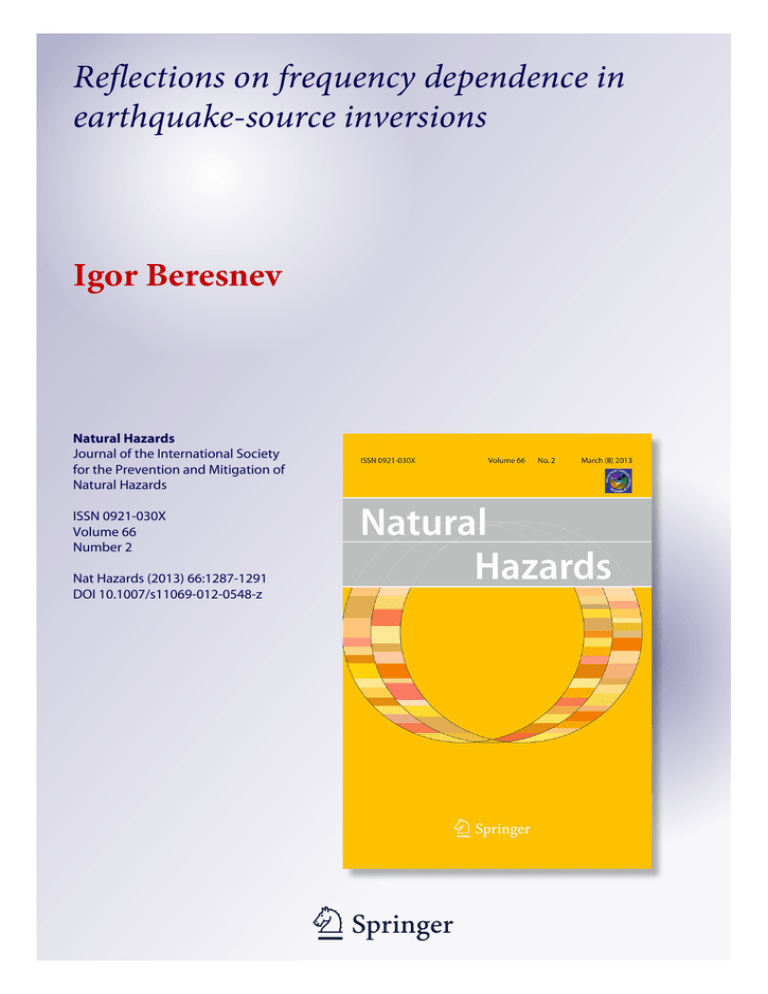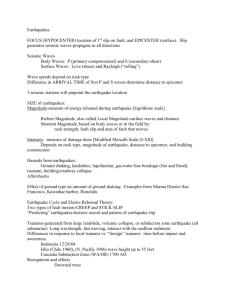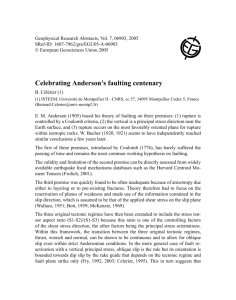Reflections on frequency dependence in earthquake-source inversions Igor Beresnev
advertisement

Reflections on frequency dependence in earthquake-source inversions Igor Beresnev Natural Hazards Journal of the International Society for the Prevention and Mitigation of Natural Hazards ISSN 0921-030X Volume 66 Number 2 Nat Hazards (2013) 66:1287-1291 DOI 10.1007/s11069-012-0548-z 1 23 Your article is protected by copyright and all rights are held exclusively by Springer Science +Business Media Dordrecht. This e-offprint is for personal use only and shall not be selfarchived in electronic repositories. If you wish to self-archive your work, please use the accepted author’s version for posting to your own website or your institution’s repository. You may further deposit the accepted author’s version on a funder’s repository at a funder’s request, provided it is not made publicly available until 12 months after publication. 1 23 Author's personal copy Nat Hazards (2013) 66:1287–1291 DOI 10.1007/s11069-012-0548-z SHORT COMMUNICATION Reflections on frequency dependence in earthquake-source inversions Igor Beresnev Received: 22 December 2012 / Accepted: 28 December 2012 / Published online: 13 January 2013 Ó Springer Science+Business Media Dordrecht 2013 Abstract The corner frequency of the spectrum of particle acceleration in a seismic wave radiated by an earthquake source marks the transition between the low-frequency band, in which the spectrum rises as frequency squared, and the high-frequency band, in which the spectrum is flat. These two distinct bands are controlled by different characteristics of faulting. The low-frequency range is governed by the value of slip alone, while the highfrequency range is controlled by both the total slip and slip velocity. This distinction explains why inversions of geodetic and shorter-period seismic data sense different characteristics of source process and are not generally comparable. Neglect of the sensitivity of seismic data to both slip and its rate may lead to false images of the inverted slip on the fault, as these characteristics trade off with each other. A recent example of the 2011 Mw 9.0 Tohoku-oki, Japan, earthquake demonstrates that the observed ‘‘frequencydependent’’ variations in the rupture process over the fault plane should not be considered unique to this particular event but rather a natural consequence of the frequency-dependent inversion. Keywords Earthquake rupture Slip Inversion 1 Introduction Inversions for the rupture process during major earthquakes are now routinely performed by numerous research groups around the world. The impressive images of rupture progression and slip distribution have tended to overshadow a wealth of uncertainties and nonuniqueness in the underlying inverse problem, which have not gone away with the addition of ‘‘gigas’’ and ‘‘teras’’ to the measures of computing. It is often overlooked that the specific inversion algorithms are only suited for the specific data types and that different data types are sensitive to different characteristics of the source process. The recent I. Beresnev (&) Department of Geological and Atmospheric Sciences, Iowa State University, 253 Science I, Ames, IA 50011-3212, USA e-mail: beresnev@iastate.edu 123 Author's personal copy 1288 Nat Hazards (2013) 66:1287–1291 example of the 2011 Mw 9.0 Tohoku-oki, Japan, earthquake highlights the importance of the correct interpretation of the characteristics of rupture obtained with different algorithms and different data sets. Specifically, I would like to contrast the information about faulting revealed by the analysis of data in varied frequency bands, that is, seismic and geodetic. 2 Source process controlling radiation in different frequency bands The differences are clearly seen from the viewpoint of radiation from a shear dislocation. According to the Aki-Brune model, the hradiated spectrum of particle acceleration in the P i or S wave is given by AðxÞ ¼ CM0 x2 = 1 þ ðx=xc Þ2 , where C is a constant independent of the fault-slip history, M0 is the seismic moment, x is the angular frequency, and xc is the corner frequency (e.g., Boore 1983). In the low-frequency band (x xc), the radiation, AðxÞ ¼ CM0 x2 ; ð1Þ is fully controlled by the moment (the final slip on the fault). In the high-frequency band (x xc), the radiation is AðxÞ ¼ CM0 x2c . The corner frequency exactly is xc ¼ evmax =U, where e is the base of the natural logarithm, vmax is the peak velocity of the slip, and U is the final slip value (Beresnev 2001). Substituting M0 ¼ lAU, where l is the shear modulus and A is the rupture area, one obtains the high-frequency spectrum AðxÞ ¼ CM0 x2c ¼ Ce2 lAv2max =U ¼ C v2max =U; ð2Þ where all slip-history-independent constants have been lumped into the new C . The highfrequency radiation (Eq. 2) carries a much stronger (square) dependence on the slip velocity than on the final slip. An important observation drawn from Eqs. (1) and (2) is that any low-frequency measure of earthquake motion (e. g., the geodetic signal) is sensitive to the displacement on the fault plane, while any high-frequency measure (the recorded seismic wave) is primarily sensitive to the rate of the fault displacement. The inversion algorithms using geodetic data will therefore reveal the slip distribution on the fault, while the algorithms using seismic data will primarily see the slip velocity on the fault. In other words, they map totally different characteristics of faulting. This is clear even from the most elementary considerations. Static slip on the fault can only produce static offset at the surface, while motion (time-varying slip) is needed to generate waves. The images obtained from geodetic and seismic observations should thus be expected to be different. 3 Example of the 2011 Mw 9.0 Tohoku-oki, Japan, earthquake The corner frequency marks the transition from one data type to the other. For a Mw 9.0 earthquake, the corner frequency is very low. One can estimate fc ¼ xc =2p as the inverse of the source rise time t0, while t0 is estimated as L=b, where L is the characteristic fault dimension and b is the shear-wave propagation speed. The 2011 Tohoku-oki earthquake ruptured the fault area with L & 200 km, which, for b & 3.5 km/s, gives t0 & 60 s. The corner frequency thus is fc & 0.02 Hz (corner period of 50 s). The inversion of observational data having frequency components above 0.02 Hz will therefore primarily sense the slip velocity, not the static slip, on the fault. 123 Author's personal copy Nat Hazards (2013) 66:1287–1291 1289 A frequency-dependent rupture process for the Tohoku-oki event was reported from the inversions by Koper et al. (2011) and Lay and Kanamori (2011). Specifically, the inversion of low-frequency (GPS and broadband teleseismic) records placed most of the slip in the shallower part of the fault, while the short-period (f & 1 Hz) radiation was inferred to emanate from the deeper part. Considering that these two types of inversions are sensitive to different characteristics of faulting (slip and slip velocity, respectively), this result should not be viewed as surprising or unique to this particular event, but rather a direct outcome of the methodologies used. The results from the two types of inversions are not even directly comparable, as the fault seen through one set of observation ‘‘glasses’’ is not the same as one seen through the other. Incorrect account of the characteristics of rupture forming seismic radiation in the highfrequency (above fc) band may lead to false images of slip distribution. Equation (2) demonstrates that the velocity of slip trades off with the slip. To provide correct results, the inversion algorithm should therefore independently solve for both slip and its rate. However, this is not what the standard least-squares, linear matrix inversion achieves. As I pointed out in an earlier publication (Beresnev 2003), to formulate a resolvable linear inverse problem, the procedure that has become standard only solves for the slips on the subfaults, presupposing a shape and duration of the elemental source time functions. A triangular shape of the seismic pulse is typically assumed, with the duration of the triangle t0 fixed and its height allowed to vary. The fixed duration means that the inversion assumes a certain slip velocity, which allows to solve solely for U. However, as Eq. (2) shows, changing the assumed vmax will inevitably change the inferred U. Equation (2) is exact. By using an approximation vmax U=t0 , it can be re-written as AðxÞ C U=t02 , which demonstrates a much stronger sensitivity of the high-frequency radiation to the assumed value of t0 than to the slip itself. The uncertainty in the resolved slip distribution, caused by fixing the width of the triangle, is simply not investigated. This approach to the inversion for fault-slip distribution during the 2011 Tohoku-oki earthquake was, for example, adopted by Lay et al. (2011), using teleseismic data with periods [3 s. Yoshida et al. (2011) use periods down to 1 s. As one can see, part of the range of periods in the data is significantly shorter than the corner period of the radiated spectrum, where the data are controlled by the slip velocity. This sensitivity is not accounted for, and the extent of the error, caused by the trade-off between vmax and U, in reproducing the true slip distribution remains unknown. Note that parameterizing the source time function as a sum of several delayed elemental triangles instead of one does not change the nature of the problem: each triangle still retains the same fixed t0, and therefore the cumulative radiation is still sensitive to its choice. 4 Combined geodetic and seismic inversions ‘‘Combined’’ inversions of geodetic and seismic records have become popular, with the idea that the combination improves the accuracy of the slip image. In light of this analysis, the utility of the combination of static-offset and seismic data in the standard linear inversion is questionable. The static slip on the fault can be resolved from geodetic displacements. Adding seismic data to the inversion supplies observations that are no longer controlled by the slip alone, but have a stronger dependence on the slip velocity. Overlooking this fact may, contrary to the expectation, degrade the quality of the inversion for 123 Author's personal copy 1290 Nat Hazards (2013) 66:1287–1291 the static slip if the algorithm is not properly modified. Using the earlier analogy, this is akin to expecting that overlaying two sets of glasses, each designed for a person with specific eyesight, will improve the vision. ‘‘Nonlinear’’ inversions are the examples of the properly modified algorithms. They resolve the difficulty of having two parameters controlling the combined data set by simultaneously solving for both (e. g., Cotton and Campillo 1995; Hernandez et al. 1999; Ji et al. 2002). Such approaches correctly avoid the parameter trade-off. However, the improvement comes at the expense of more complex algorithms, typically solving for several source variables instead of one in the case of the linear matrix inversion. They typically result in greater instability and suffer from their own, still inadequately understood, sources of non-uniqueness (Beresnev 2003). It remains to be seen if the increase in the complexity of source parameterization leads to better images of reality. 5 Conclusions This paper makes two points: 1. For an earthquake source, the inversion result depends on the frequency range of the data used, because different frequency bands map different physical processes on the fault (namely, slip vs. slip velocity). This should be expected for every fault, small or large, and should not be construed as a unique phenomenon. For large ruptures, as in the Tohoku-oki event, the low- and high-frequency images may become spatially separated, as found by Koper et al. (2011) and Lay and Kanamori (2011). For small ruptures, different images of the same source will result in the respective bands. 2. An inversion for the slip alone in the high-frequency range may lead to erroneous results, because the high-frequency field is sensitive to both slip and slip velocity. Stronger-than-ever reliance is being placed on finite-fault inversions for earthquake ruptures in making seismological and geological inferences from past earthquakes. As routine applications grow, there is a tendency to neglect that the inversion algorithms are still not ‘‘established science.’’ The often stunning uncertainties are not well understood and oftentimes ‘‘swept under the rug.’’ The compounding factor is that the true earthquake slip is never known, making the inversions virtually unverifiable. A temptation exists to overuse this fact. As the case of the 2011 Tohoku-oki earthquake demonstrates, a ‘‘frequency-dependent’’ rupture simply arises from the frequency-dependent inversion. Correct interpretation of the inversion images, the use of the algorithms appropriate for the specific data types, and candid exposure of all the uncertainties are still overdue tasks. References Beresnev IA (2001) What we can and cannot learn about earthquake sources from the spectra of seismic waves. Bull Seism Soc Am 91:397–400 Beresnev IA (2003) Uncertainties in finite-fault slip inversions: to what extent to believe? (A critical review). Bull Seism Soc Am 93:2445–2458 Boore DM (1983) Stochastic simulation of high-frequency ground motions based on seismological models of the radiated spectra. Bull Seism Soc Am 73:1865–1894 Cotton F, Campillo M (1995) Inversion of strong ground motion in the frequency domain: application to the 1992 Landers, California, earthquake. J Geophys Res 100:3961–3975 Hernandez B, Cotton F, Campillo M (1999) Contribution of radar interferometry to a two-step inversion of the kinematic process of the 1992 Landers earthquake. J Geophys Res 104:13083–13099 123 Author's personal copy Nat Hazards (2013) 66:1287–1291 1291 Ji C, Wald DJ, Helmberger DV (2002) Source description of the 1999 Hector Mine, California, earthquake, part I: wavelet domain inversion theory and resolution analysis. Bull Seism Soc Am 92:1192–1207 Koper KD, Hutko AR, Lay T, Ammon CJ, Kanamori H (2011) Frequency-dependent rupture process of the 2011 Mw 9.0 Tohoku Earthquake: comparison of short-period P wave backprojection images and broadband seismic rupture models. Earth Planets Space 63:599–602 Lay T, Kanamori H (2011) Insights from the great 2011 Japan earthquake. Phys Today 64:33–39 Lay T, Ammon CJ, Kanamori H, Xue L, Kim MJ (2011) Possible large near-trench slip during the 2011 Mw 9.0 off the Pacific coast of Tohoku Earthquake. Earth Planets Space 63:687–692 Yoshida Y, Ueno H, Muto D, Aoki S (2011) Source process of the 2011 off the Pacific coast of Tohoku Earthquake with the combination of teleseismic and strong motion data. Earth Planets Space 63: 565–569 123





